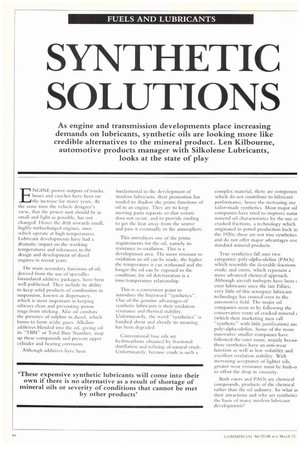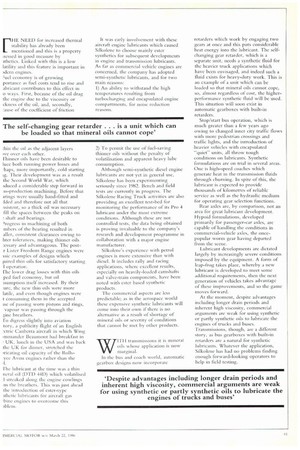SYNTHETIC SOLUTIONS
Page 64

Page 65

If you've noticed an error in this article please click here to report it so we can fix it.
As engine and transmission developments place increasing demands on lubricants, synthetic oils are looking more like credible alternatives to the mineral product. Len Kilbourne, automotive products manager with Silkolene Lubricants, looks at the state of play
F_ 4 NGINE power outputs of trucks, buses and coaches have been on
the increase for many years. At the same time the vehicle designer's view, that the power unit should be as small and light as possible, has not changed. Hence the drift towards small, highly turbocharged engines, ones which operate at high temperatures. Lubricant developments have had a dramatic impact on the working temperatures and tolerances in the design and development of diesel engines in recent years.
The main secondary functions of oil, derived from the use of speciallyformulated additive packages, have been well publicised. They include its ability to keep solid products of combustion in suspension, known as dispersancy, which is most important in keeping oilways clean and preventing piston rings from sticking. Also oil combats the presence of sulphur in diesel, which burns to form acidic gases. Alkaline additives blended into the oil, giving oil its "TBN" or Total Base Number, mop up these compounds and prevent upper cylinder and hearing corrosion.
Although additives have been fundamental in the development of modern lubricants, their promotion has tended to shadow the prime functions of oil in an engine. They are to keep moving parts separate so that seizure does not occur, and to provide cooling to get the heat away from the source and pass it eventually to the atmosphere.
This introduces one of the prime requirements for the oil, namely its resistance to oxidation. This is a development area. The more resistant to oxidation an oil can be made, the higher the temperature it can withstand and the longer the oil can be exposed to the condition; for oil deterioration is a time/temperature relationship.
This is a convenient point to introduce the buzzword "synthetics". One of the genuine advantages of synthetic lubricants is their oxidation resistance and thermal stability. Unfortunately, the word "synthetics" is bandied about and already its meaning has been degraded.
Conventional base oils are hydrocarbons obtained by fractional distillation and refining of natural crude. Unfortunately, because crude is such a complex material, there are componen which do not contribute to lubricant performance, hence the increasing use tailor-made synthetics. Most major oil companies have tried to improve natut mineral oil characteristics by the use oi cracked fractions, a technology which originated in petrol production back in the 1920s; these are not true synthetics and do not offer major advantages ovc standard mineral products.
True synthetics fall into two categories: poly-alpha-olefins (PA0s) which resemble the desirable fractions crude; and esters, which represent a more advanced chemical approach. Although aircraft turbojets have been ester lubricants since the late Fifties, very little of this aerospace lubricant technology has crossed over to the automotive field. The major oil companies seem to be following the conservative route of cracked mineral (which their marketing men call "synthetic" with little justification) ane poly-alpha-olefins. Some of the more innovative smaller companies have followed the ester route, mainly becaui these synthetics have an anti-wear function as well as low volatility and excellent oxidation stability. With increasing acceptance of lighter oils, greater wear resistance must be built-ix to offset the drop in viscosity.
Both esters and PAOs are chemical compounds, products of the chemical rather than the oil industry. So what ai their attractions and why are synthetics the basis of many modern lubricant developments?
rD HE NEE for increased thermal
stability has already been
mentioned and this is a property sessed in good measure by
ithetics. Linked with this is a low latility and this feature is important in >dem engines.
Fuel economy is of growing portance as fuel costs tend to rise and abricant contributes to this effect in o ways. First, because of the oil drag the engine due to the viscosity or ckness of the oil, and, secondly, muse of the coefficient of friction thin the oil as the adjacent layers ive over each other.
chinner oils have been desirable to Ince both running power losses and .haps, more importantly, cold starting g. Their development was as a result the Second World War, which aced a considerable step forward in .ss-production machining. Before that arings were usually hand-fitted and ided and therefore not all that asistent, so a thick oil was necessary fill the spaces between the peaks on shaft and bearings.
?rogress in machining of both .mbers of the bearing resulted in aller, consistent clearances owing to hter tolerances, making thinner oils :essary and advantageous. The postr Lister Freedom Range engines were ssic examples of designs which luired thin oils for satisfactory starting 3 operation.
Me lower drag losses with thin oils pcd fuel economy, hut oil
asumption itself increased. By their ure, the new thin oils were more La tile, and even though engines were t consuming them in the accepted Ise of passing worn pistons and rings, vapour was passing through the sine breathers. ro digress slightly into aviation tory, a publicity flight of an English
!ctric Canberra aircraft in which Wing ■ mmander Beaumont had breakfast in UK, lunch in the USA and was back the UK for dinner, stretched the iricating oil capacity of the Rollsyce Avon engines rather than the
rho lubricant at the time was a thin neral oil (I)T1) 441)) which volatilised .1 streaked along the engine cowlings rn the breathers. This was just ahead the introduction of ester-type
nhetic lubricants for aircraft gas .bino engines to overcome this It was early involvement with these aircraft engine lubricants which caused Silkolene to choose mainly ester synthetics for subsequent developments in engine and transmission lubricants. As far as commercial vehicle engines are concerned, the company has adopted semi-synthetic lubricants, and for two main reasons: An ability to withstand the high temperatures resulting from turbocharging and encapsulated engine compartments, for noise reduction reasons.
2) To permit the use of fuel-saving thinner oils without the penalty of volatilisation and apparent heavy lube consumption.
Although semi-synthetic diesel engine lubricants are not yet in general use, Silkolene has been experimenting seriously since 1982. Bench and field tests are currently in progress. The Silkolene Racing Truck activities are also providing an excellent test-bed for monitoring the performance of its Pro 4 lubricant under the most extreme conditions. Although these are not controlled tests, the data being obtained is proving invaluable to the company's research and development programme in collaboration with a major engine manufacturer.
Silkolene's experience with petrol engines is more extensive than with diesel. It includes rally and racing applications, where excellent results, especially on heavily-loaded camshafts and valve-train components, have been noted with ester based synthetic products.
The commercial aspects are less predictable; as in the aerospace world these expensive synthetic lubricants will conic into their own if there is no alternative as a result of shortage of mineral oils or severity of conditions that cannot he met by other products.
WITI I transmissions it is mineral oils whose application is now marginal. In the bus and coach world, automatic gearbox designs now incorporate retarders which work by engaging two gears at once and this puts considerable heat energy into the lubricant. The selfchanging gear retarder, which is a separate unit, needs a synthetic fluid for the heavier truck applications which have been envisaged, and indeed such a fluid exists for heavy-duty work. This is an example of a unit which can be loaded so that mineral oils cannot cope, so, almost regardless of cost, the higherperformance synthetic fluid will be used. This situation will soon exist in automatic gearboxes with built-in retarders.
Stop/start bus operation, which is much greater than a few years ago owing to changed inner city traffic flows with more pedestrian crossings and traffic lights, and the introduction of heavier vehicles with encapsulated "quiet" units, all throw tough conditions on lubricants. Synthetic formulations are on trial in several areas. One is high-speed coaches which generate heat in the transmission fluids through churning. In spite of this, the lubricant is expected to provide thousands of kilometres of reliable service as well as the hydraulic medium for operating gear selection functions.
Rear axles are, by comparison, not an area for great lubricant development. Hypoid formulations, developed primarily for passenger-car axles, arc capable of handling the conditions in commercial-vehicle axles, the oncepopular worm gear having departed from the scene.
Lubricant developments are dictated largely by increasingly severe conditions imposed by the equipment. A form of leap-frog takes place, whereby a new lubricant is developed to meet some additional requirements, then the next generation of vehicles takes advantage of these improvements, and so the game moves forward.
At the moment, despite advantages including longer drain periods and inherent high viscosity, commercial arguments are weak for using synthetic or partly synthetic oils to lubricate the engines of trucks and buses. Transmissions, though, are a different story, as bus gearboxes with built-in retarders are a natural for synthetic lubricants. Whatever the application, Silkolene has had no problems finding enough forward-looking operators to help in field testing.






















































































